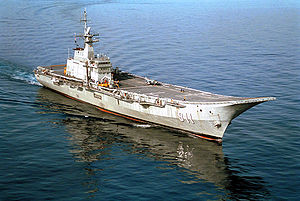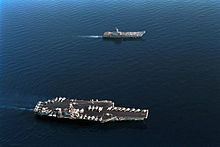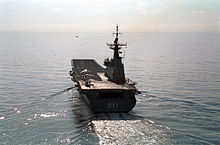- HTMS Chakri Naruebet
-
HTMS Chakri Naruebet underway in the South China Sea in early 2001Career (Thailand) 
Name: HTMS Chakri Naruebet Namesake: "In honour of the Chakri Dynasty" Ordered: 27 March 1992 Builder: Bazán, Ferrol, Spain Cost: US$336 million Laid down: 12 July 1994 Launched: 20 January 1996 Commissioned: 27 March 1997 Homeport: Sattahip Motto: Rule The Sky, Rule The Sea, Chakri Naruebet. (ครองเวหา ครองนที จักรีนฤเบศร) Status: Operational as of 2011 Badge: 
General characteristics Type: V/STOL carrier Displacement: 11,486 tons full load Length: 182.65 m (599.2 ft) (overall)
174.1 m (571 ft) (flight deck)
164.1 metres (538 ft) (between perpendiculars)Beam: 22.5 m (74 ft) (waterline)
30.5 m (100 ft) maximumDraught: 6.12 m (20.1 ft) Propulsion: 2 x GE LM2500 gas turbines providing 22,125 shp (16,499 kW)
2 x Bazán-MTU 16V1163 TB83 diesel engines providing 5,600 bhp (4,200 kW)
2 x shafts with 5-bladed propellersSpeed: 25.5 knots (47.2 km/h; 29.3 mph) (maximum)
17.2 knots (31.9 km/h; 19.8 mph) (cruising)Range: 10,000 nautical miles (19,000 km; 12,000 mi) at 12 knots (22 km/h; 14 mph)
7,150 nautical miles (13,240 km; 8,230 mi) at 16.5 knots (30.6 km/h; 19.0 mph)Troops: Up to 675 soldiers Complement: 62 officers
393 sailors
146 aircrewSensors and
processing systems:Hughes SPS-52C air search radar, E/F band
2 x Kelvin-Hughes 1007 navigational radarsElectronic warfare
and decoys:Decoys:
4 x SRBOC decoy launchers
SLQ-32 towed decoyArmament: 2 x 0.5-inch machine guns
3 x dual Mistral surface-to-air missile launchersAircraft carried: 6-8 AV-8S Matadors
4-6 S-70B Seahawks
Up to 14 additional helicopters when requiredAviation facilities: 174.6-by-27.5-metre (573 by 90 ft) flight deck
12° ski-jump
Hangar space for 10 aircraftNotes: Equipment fitted for but not with is listed in the article HTMS Chakri Naruebet (Thai จักรีนฤเบศร, meaning "In honour of the Chakri Dynasty"[1]) is the flagship of the Royal Thai Navy (RTN), and Thailand's first and only aircraft carrier. Based on the Spanish Navy's Principe de Asturias design and constructed by Spanish shipbuilder Bazán, Chakri Naruebet was ordered in 1992, launched in 1996, and commissioned into the RTN in 1997.
The carrier is designed to operate an air group of V/STOL fighter aircraft and helicopters, and is fitted with a ski-jump, although by 1999, the Matador V/STOL aircraft were inoperable, and flight operations were limited to helicopters. Chakri Naruebet was intended for patrols and force projection in Thai waters, disaster relief, and amphibious warfare support. However, a lack of funding brought on by the 1997 Asian Financial Crisis means that the carrier has spent much of her career docked at the Sattahip naval base.
Chakri Naruebet has been deployed on several disaster relief operations, including in the aftermath of the 2004 Indian Ocean earthquake and tsunami, and in response to separate flooding incidents in late 2010 and early 2011. Outside of disaster relief, most of the ship's other departures from port consist primarily of a single training day per month, and transportation of the Royal Family of Thailand, leading to claims by some naval commentators that the ship is merely an oversized royal yacht.[1][2]
Contents
Design
When Typhoon Gay hit Thailand in 1989, the Royal Thai Navy, as the main unit responsible for search and rescue missions, found that its ships and aircraft were unable to withstand the rough weather at sea.[3] Moreover, the Royal Thai Navy needed a new, high-technology ship to modernize its fleet.[3]
The original plan was to acquire a 7,800 ton vessel from Bremer Vulcan, but the Thai government cancelled the contract on 22 July 1991.[4] A new contract for a larger warship to be constructed at Bazán's shipyard in Ferrol, Spain, and was signed by the Thai and Spanish governments on 27 March 1992.[4] The proposed vessel was based on the design of the Spanish Navy aircraft carrier Principe de Asturias, which in turn was based on the United States Navy's Sea Control Ship concept.[5][2]
Chakri Naruebet is the smallest aircraft carrier in operation in the world. She displaces 11,486 tons at full load.[1] The carrier is 164.1 metres (538 ft) long between perpendiculars, and 182.65 metres (599.2 ft) overall.[1] She is 22.5 metres (74 ft) wide at the waterline, with a maximum beam of 30.5 metres (100 ft), and a draught of 6.12 metres (20.1 ft).[1] The warship has a ship's company of 62 officers, 393 sailors, and 146 aircrew.[1] Up to 675 personnel can be transported; commonly soldiers of the Royal Thai Marine Corps.[1][6]
Chakri Naruebet is propelled by a combined diesel or gas (CODOG) system.[1] Each of the two, five-bladed propellers is connected to a Bazán-MTU 16V1163 TB83 diesel engine (providing 5,600 brake horsepower (4,200 kW), used for cruising speed), and a General Electric LM2500 gas turbine (providing 22,125 shaft horsepower (16,499 kW), used to reach top speed for short periods).[1] Chakri Naruebet has a maximum speed of 25.5 knots (47.2 km/h; 29.3 mph), although she can only reach 17.2 knots (31.9 km/h; 19.8 mph) with the diesels alone.[1] She has a maximum range of 10,000 nautical miles (19,000 km; 12,000 mi) with a constant speed of 12 knots (22 km/h; 14 mph), and 7,150 nautical miles (13,240 km; 8,230 mi) at 16.5 knots (30.6 km/h; 19.0 mph).[1]
Armament and aircraft
Chakri Naruebet is fitted with two 0.5-inch machine guns, and three Matra Sadral sextuple surface-to-air missile launchers firing Mistral missiles.[4][6] The missile launchers were installed in 2001.[4] The vessel is also fitted for but not with an 8-cell Mark 41 Vertical launch system for Sea Sparrow missiles, and four Phalanx close-in weapon systems.[2]
The carrier was designed to operate an air group of six to eight AV-8S Matador V/STOL aircraft (a first generation export version of the Harrier acquired secondhand from the Spanish Navy), which were delivered with Chakri Naruebet as part of a package deal,[citation needed] plus four to six S-70B Seahawk helicopters.[1][5][6] By 1999, only one Matador was still airworthy,[7] and the RTN was seeking replacement aircraft or attack helicopters.[citation needed] Chakri Naruebet is also capable of carrying up to fourteen additional helicopters; a mix of Sikorsky Sea King, Sikorsky S-76, and CH-47 Chinook.[1] There is only enough hangar space for ten aircraft.[4][6]
The flight deck measures 174.6 by 27.5 metres (573 by 90 ft).[4] A 12° ski-jump assists V/STOL aircraft to take off.[4] There are two aircraft lifts, each capable of lifting 20 tons.[4]
Sensors and countermeasures
The sensor suite of Chakri Narebet consists of a Hughes SPS-52C air search radar operating on the E/F band, and two Kelvin-Hughes 1007 navigational radars.[4] There are provisions to install an SPS-64 surface search radar and a hull-mounted sonar, but neither has been fitted as of 2008.[4][6] Fire control facilities are also yet to be fitted.[4]
The carrier is equipped with four SRBOC decoy launchers,[6] and an SLQ-25 towed decoy.[citation needed]
Construction
Work on the Thai carrier commenced in October 1993, although it was not until 12 July 1994 that the hull was laid down.[4][2] Chakri Naruebet was launched on 20 January 1996[2] by Queen Sirikit.
Sea trials were conducted from October 1996 to January 1997, the latter part of which was in coordination with the Spanish Navy.[4][2] This was followed by aviation trials at Rota, Spain.[4] The carrier was handed over on 27 March 1997, when she was commissioned into the RTN.[1][4] She arrived in Thai waters at the start of August 1997, and formally entered service on 10 August.[2]
Chakri Naruebet cost US$336 million to build.[7]
Role and operational history
Chakri Naruebet is the first aircraft carrier to be operated by a Southeast Asian nation.[2] She is assigned to the Third Naval Area Command, and her intended duties include operational support of the RTN's amphibious warfare forces, patrols and force projection around Thailand's coastline and economic exclusion zone, disaster relief and humanitarian missions, and search-and-rescue operations.[1][4][5][2][7] However, at the time the carrier entered service, the 1997 Asian Financial Crisis prevented the necessary funding to operate the ship from being available.[2][7] Consequently, Chakri Naruebet is usually only operational for a single day per month for training, with the rest of the time spent alongside as a "part-time tourist attraction".[1][2][7] The ship rarely leaves the proximity of the Sattahip naval base, and when she does, it is usually to transport and host the Royal Family of Thailand.[1][2] Naval commentators consider Chakri Naruebet to be less an aircraft carrier and more the world's most expensive royal yacht, while the Thai media have nicknamed the ship "Thai-tanic", and consider her to be a white elephant.[2][7]
Between 4 and 7 November 1997, Chakri Naruebet participated in disaster relief operations following the passage of Tropical Storm Linda across the Gulf of Thailand and the Kra Isthmus.[8] The carrier's main task was to search for and assist any fishing vessels affected by the storm.[8]
Flooding in the Songkhla Province resulted in the carrier's mobilisation in late November 2000.[8] Chakri Naruebet was anchored at an island marina off Songkhla, and used as a base for helicopters and small boats transporting food, supplies, and wounded.[8]
In January 2003, anti-Thai riots were sparked in Phnom Penh by incorrect news reports of a claim by a Thai actress that the Angkor Wat temple complex belonged to Thailand, not Cambodia. Chakri Naruebet was sent to help with any evacuation of Thai citizens from Cambodia.[clarification needed][8]
Following an undersea earthquake in the Indian Ocean, tsunamis struck multiple regions around the Indian Ocean, including the Andaman Sea coast of Thailand. The personnel of Chakri Naruebet were part of a 760-strong response by the Thai military to the disaster.[8] This task force was involved in search-and-rescue around Phuket and the Phi Phi Islands, treatment of wounded and handling of dead, and repair work to schools and government facilities.[8]
During the August 2005 filming of Rescue Dawn, a dramatised biographical film of US Navy pilot Dieter Dengler and his capture during the Vietnam War, the flight deck of Chakri Naruebet was used to represent the carrier USS Ranger.[citation needed]
In November 2010, the ship was involved in flood relief operations following the 2010 Thai floods; anchored off Songkhla Province, relief supplies and food were airlifted to people in the region, while hospital patients were evacuated by the ship's helicopters.[9] Chakri Naruebet was sent to Koh Tao in late March during the 2011 Southern Thailand floods, as the heavy stoms causing the flooding had isolated the island, requiring the evacuation of tourits and local citizens.[10] Coordinates: 12°37′33″N 100°54′49″E / 12.625836°N 100.913536°E
Citations
- ^ a b c d e f g h i j k l m n o p q Werthem (ed.), Naval Institute Guide to Combat Fleets of the World, p. 772
- ^ a b c d e f g h i j k l m Bishop & Chant, Aircraft Carriers, p. 88
- ^ a b Past[clarification needed], Royal Thai Navy
- ^ a b c d e f g h i j k l m n o p Saunders (ed.) Jane's Fighting Ships 2008-2009, p. 786
- ^ a b c Ireland, The Illustrated Guide to Aircraft Carriers of the World, p. 249
- ^ a b c d e f Bishop & Chant, Aircraft Carriers, p. 89
- ^ a b c d e f Carpenter & Wiencek, Asian Security Handbook 2000, p. 302
- ^ a b c d e f g Chakri Nauebet disaster relief missions, Royal Thai Navy
- ^ Earth Times, Thai aircraft carrier used as floating kitchen
- ^ Bangkok Post, Navy races South to aid victims
References
- Books
- Bishop, Chris; Chant, Christopher (2004). Aircraft Carriers: the world's greatest naval vessels and their aircraft. London: MBI. ISBN 0760320055. OCLC 56646560. http://books.google.com/books?id=PY8CvlKC7kgC.
- Carpenter, William M.; Wiencek, David G. (2000). Asian Security Handbook 2000. M. E. Sharpe. ISBN 9780765607157. http://books.google.com/books?id=_Dc665HSo_0C.
- Ireland, Bernard (2008) [2005]. The Illustrated Guide to Aircraft Carriers of the World. London: Anness Publishing. ISBN 9781844777471. OCLC 156616762.
- Saunders, Stephen (ed.) (2008). Jane's Fighting Ships 2008-2009. Jane's Fighting Ships (111th ed.). Surrey: Jane's Information Group. ISBN 9780710628459. OCLC 225431774.
- Wertheim, Eric, ed (2007). The Naval Institute Guide to Combat Fleets of the World: Their Ships, Aircraft, and Systems (15th ed.). Annapolis, MD: Naval Institute Press. ISBN 9781591149552. OCLC 140283156. http://books.google.com/books?id=TJunjRvplU4C.
- News articles
- "Navy races South to aid victims". Bangkok Post. 30 March 2011. http://www.bangkokpost.com/news/local/229361/navy-races-south-to-aid-victims. Retrieved 25 April 2011.
- "Thai aircraft carrier used as floating kitchen". Earth Times. 3 November 2010. http://www.earthtimes.org/articles/news/351700,aircraft-carrier-floating-kitchen.html. Retrieved 25 April 2011.
- Websites
- "Chakri Nauebet disaster relief missions" (in Thai). Royal Thai Navy. http://www.navy.mi.th/cvh911/chakrihelp.html. Retrieved 25 April 2010.
- "Past" (in Thai). Royal Thai Navy. http://www.navy.mi.th/cvh911/past.html. Retrieved 25 April 2010.[clarification needed]
External links
Admiral Kuznetsov • Cavour • Centaur (Hermes subclass) / Viraat • Chakri Naruebet • Charles de Gaulle • Enterprise • Giuseppe Garibaldi • Invincible • Juan Carlos I • Nimitz • Príncipe de Asturias • Clemenceau / São Paulo
Categories:- Aircraft carriers of the Royal Thai Navy
- Ships built in Spain
- 1996 ships
- Unique aircraft carriers
- Active aircraft carriers of Thailand
Wikimedia Foundation. 2010.



